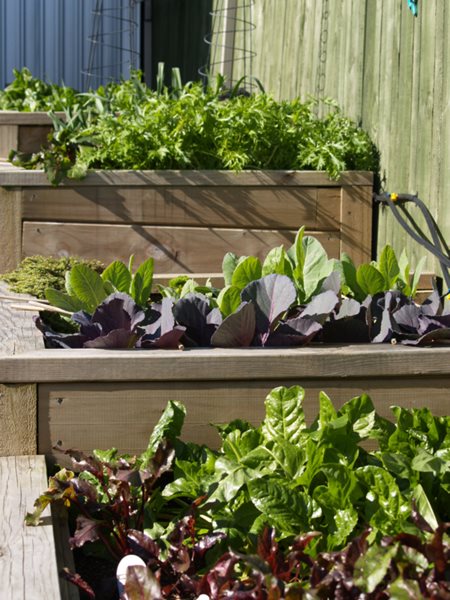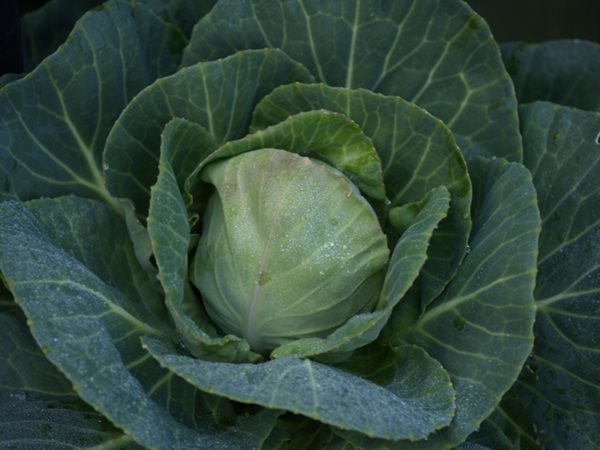Vegetables in New Zealand
A compact garden of raised beds near the beach in New Zealand produces "six packs" of vegetables all year round for this couple, a pair of fine art photographers.

Monica Moriyasu and her partner Warren Brown, both fine art photographers, live in Red Beach, Auckland, in New Zealand and have created their garden on a 550 square meter lot (1/10 of an acre).
With a garden focusing predominantly on vegetables, Moriyasu and Brown are currently still harvesting their vegetables in winter—since New Zealand's summer months start in December—and are planning for even more bounty over the coming months!
"Like many in these times, we have many former lives and occupations," says Moriyasu. "Warren is a former industrial chemist specializing in fertilizer, and a computer guru. I started my career as a chef, and have followed many creative occupations since, including house and garden design."
But the pair have always loved gardening and their garden reflects their sustainable and practical approach to life.

Tell us a little bit about your garden:
My new vegetable garden is in raised beds for ease of management in my "old age." I spent this morning harvesting lettuce, beets, and spinach that were just going to seed.
We started the raised beds along the fence line in winter, and harvested sweet broccoli, spinach and multitudes of Swiss chard. I even tried my hand at some winter lettuce (romaine) but it didn’t like the cold wind here.
How long have you been gardening?
I have been gardening as long as I can remember. My mother kept 3/4 of an acre of garden, and I grew up in a paradise surrounded by fragrant flowers and shrubs. Gardens are such a sensory experience to me, and I love to touch as much as I love to look and smell.
Warren likes New Zealand natives, fruit trees and vegetable gardens. His gardening goes back a long way, too.
Four planter bins, looking up the row one to four. First row: perpetual spinach, long red beets. Second row: red mini cabbage, mini white cauliflower, lemon thyme creeping over the corner. Third row: ‘Cardiff’ leeks, mizuna (winter lettuce), red beets, snow peas. Fourth row: perpetual spinach, ‘White Lisbon’ green onions.

Where is your garden located?
Our lot is only 550 square meters. We live near the beach just half an hour north of Auckland City, New Zealand. Our climate is Mediterranean with some salt laden air, and we face the southwest. We get lots of cold wind in the winter, and a cooling breeze in summer.
My very able partner, Warren built all the raised beds and has added some irrigation to them. We plan on building more raised beds around our back deck. Living in a housing subdivision where privacy is hard to find, we felt we wanted to create a garden that was both lovely to look at, would help feed us, and would be practical, all at the same time.
The two sturdy wire cages are being climbed by snow peas. They sit next to the ‘Cardiff’ leeks backed by the mizuna, with a few red beets thrown in for color in the front.

What kind of vegetables do you grow in your garden?
I have planted a wide variety of lettuce including green and red oak leaf, mini cos (romaine in the United States), buttercrunch, iceberg, and wavy red. The broccoli is slower in summer, but half a dozen plants will feed us for a couple of weeks when they finally bear fruit.
My mini cabbages. I plant them close together to keep the soil moist and relatively weed free.
Learn more about raised bed gardens.

Any other vegetables?
I also have coriander, dill, green onions, garlic, and ordinary chives planted. A seperate container with common mint also contributes to summer salads. We also have five varieties of tomato planted: an heirloom variety, which isn’t producing very well; a hybrid, which isn’t producing at all, but it has lovely foliage; 'Sweet 100,' which are juicy delights to eat off the vine or with salad; roma; and beefsteak.
Mizuna. I call this the winter lettuce. It is an excellent lettuce substitute in the middle of winter and grows incredibly well in areas that don’t have snow or too much frost.

What kind of challenges did you have in your garden?
Because ours is a sloping lot with clay soil, it didn’t lend itself for ground level gardening. I also wanted to include companion flowers and edible plantings to encourage the bees to visit.
We bought our home as a new house on a bare lot two years ago. In typical subdivision fashion, the developers removed the majority of the top soil and never put it back. With a clay substrate, the drainage is almost non-existent, which is another reason for creating raised beds filled with a soil and compost mix.
We live in an area just 32 kilomenters north of Auckland called the Hibiscus Coast. This area is subtropical and the winter is exceptionally cold with snow flurries and hail that settles on the ground. Our home faces the south, so we are battered by the southwesterly winds that blow straight from Antarctica in the winter. The garden has to be able to withstand not only the winds, but also the cold.
The hedges will eventually provide much needed privacy in this small and close suburban lot.

How long have you been working on this garden?
The garden has been a work in progress for the past year. Being a new home on a bare house lot, we knew we wanted to have a sustainable garden. We have two compost bins in operation and will harvest that ‘black gold’ in the very near future.
How do you think the garden reflects you and your family?
My friends joke about the "neatnik" garden that they say they would expect from Warren and myself, as we like order in our lives. We feel this is the best use of the small space, and makes life very easy for harvest and planting.
Nandina grow in pots, sharing the deck with orchids of different varieties. A shade sail is essential for the summer months and keeps the harsh New Zealand light off the interior of the house. The screen on the left which faces the southern neighbours, creating privacy and cutting down on the ferocious wind.

Why did you decide to plant these particular vegetables?
We decided on the mini varieties of our favorite winter vegetables because one can eat only so many cabbages and cauliflower. With so much spinach, we find we can feed not only ourselves, but also my elderly mother and sometimes the neighbors as well. As most vegetable starts come in six-packs, you know that you will have to eat six cabbages and s on in quick succession.
A mini cabbage with the frost thawing on the leaves. This head is approximately 4 inches across.

What draws you to gardening?
Gardening is food for the soul. You have to be "in the moment" when you are gardening. We have been known to shed a tear at the beauty of a garden or a certain flower.
Do you plant any flowers?
I planted marigolds and petunias. The latter smell glorious day and night, and in purple and white, they look fabulous with the predominance of bright green vegetable plantings. I am passionate about roses, but don’t have the space to grow them.
Pansies, stock, and white polyanthus keep the rhubarb company in this shady bed.

Do you have a philosophy about gardening?
We like to have a garden that will feed us and the neighbors, too. Our hedges are also fruit bearing (Feijoa or pineapple guava). We want it to be somewhere to go when we need time for reflection and to just get away from the business of life.
This rather motley looking bunch of strawberries just kept blooming and producing all year round. The strawberry bag is a useful way to grow the berries, though the ones at the back don’t do as well out of the full sun.

What draws you to gardening?
Gardening is food for the soul. You have to be "in the moment" when you are gardening. We have been known to shed a tear at the beauty of a garden or a certain flower.
Red beet leaves are so decorative en masse—this variety is about four inches long when mature.

How often do you visit your garden?
This is the middle of winter, so we would rather enjoy our garden from the inside. I venture outside only long enough to harvest the vegetables and do the small amount of weeding and plucking necessary to keep the garden looking its best.
Because I tend to ‘crowd’ the vegetables together, the weeding is negligible and the soil stays damp in summer. Drainage is excellent and my only real challenge then is keeping the cats off the turned soil and new plantings. Hence the bamboo grids!
What do you have planned for the future?
We have plans for more decking and trellis for both wind shelter and shade, and more planters. The summers can be very hot and humid and shade in the garden then becomes an issue. Without large trees for shade, we have to adapt with appropriate plantings.
Young parsley grows next to a new garlic chives and spreading lemon thyme, ‘Mini White’ cauliflower and ‘Red Mini’ cabbages. The bamboo stakes serve dual purpose of keeping the young plants upright in the wind and keeping the cats off the newly turned soil and new plants. The next planter down supports a more mature crop of perpetual spinach and red beets. The planter at the bottom grows mini cabbages and mini leeks grow in the green plastic planter in front.




